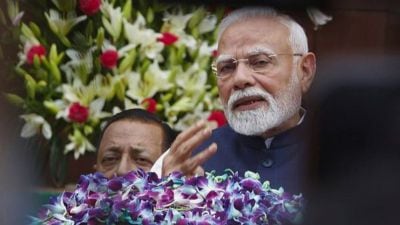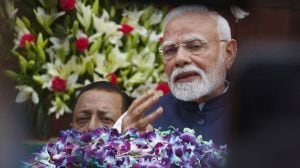LeT’s Muridke camp targeted in Operation Sindoor also trained Bengaluru Indian Institute of Science attacker in 2002-03
The Markaz Taiba Training Centre of the LeT in Muridke was established in the year 2000 and comprises a complex spread over 82 acres with a madrasa, residential quarters, classrooms, sports fields, a market, fish farms, and agricultural land.
 A satellite image shows Markaz Taiba following airstrikes in Muridke, Pakistan. (Source: Reuters)
A satellite image shows Markaz Taiba following airstrikes in Muridke, Pakistan. (Source: Reuters)One of the Lashkar-e-Toiba (LeT) terrorist centres that Indian armed forces claimed to have attacked during Operation Sindoor – the Markaz Taiba in Muridke, near Lahore, deep in Pakistan – is infamous as the camp where the terrorists involved in the 26/11 Mumbai attacks were trained.
Long before the 2008 attacks on Mumbai, in the early years of the LeT’s Markaz Taiba camp at Muridke, an Indian origin terrorist who is one of the prime accused in the December 28, 2005, LeT attack on the Indian Institute of Science in Bengaluru – which killed an IIT professor from Delhi, M C Puri – was also trained at the centre.
Sabahuddin Ahmed, 40, who was 20 years old when he facilitated the IISc attack in Bengaluru, trained as a teenager at the Markaz Taiba camp in 2002-03 and provided early insights on the activities at the camp, according to police reports compiled in UP and Karnataka following his arrest in UP in January 2008.
Ahmed, who is being held in a prison in UP, is currently undergoing trial in a Bengaluru special court for the IISc attack. Charges were framed against him in 2021 for the 2005 LeT terror attack on IISc – where he used the camouflage of a student at a local college to set up a base in Bengaluru for the eventual attack by LeT gunman ‘Abu Hamza’, who arrived from Pakistan.
Incidentally, the main attacker in the IISc case, ‘Abu Hamza’, is also linked to the 2008 Mumbai attacks as one of the trainers at the Markaz Taiba camp. While Sabahuddin Ahmed was also initially linked to the Mumbai attacks as a provider of information on key locations in Mumbai to his LeT handlers, he was acquitted in the case in 2011.
Sabahuddin Ahmed, who hails from Bihar, is reported to have attended the LeT camp at Muridke in the 2002-03 period as a 17-year-old after being reportedly identified by LeT leaders for engaging in terrorist activities in India. Ahmed is reported to have been drawn to the LeT by speeches made by LeT leader Hafiz Saeed in Lahore in 2002. Ahmed was among a group of jihad trainees from India sent via Kashmir to Pakistan in 2002.
Sabahuddin Ahmad, who spent two periods with Lashkar leaders, first in 2002-2003 and then in 2006, when he escaped after the IISc attack, told police interrogators that LeT military commander Zaki-ur-Rehman Lakhvi personally recommended him to the Inter-Services Intelligence (ISI) of the Pakistan army after his recruitment.
“He asked me to go to the ISI agency and work with them as they needed a dedicated jihadi for the work,” Sabahuddin Ahmed alias Saba alias Farhan told investigators in 2008 regarding his first training tenure in Pakistan in 2002-03. According to accounts gathered by security agencies, Ahmed was in a LeT safe house at Muridke for over three months in late 2002 and early 2003.
After his training concluded in March 2003, Sabahuddin Ahmed said he was given Rs 25,000 and was dropped at the Lahore airport by an ISI official. In the subsequent days after his training, Sabahuddin Ahmed said he stayed in touch with only his LeT handlers – Muzammil alias Yousuf and his then second in command Abdul Aziz, from whom he received orders for an attack in Bengaluru.
Ahmed’s LeT handlers from the 2005 period are incidentally also linked to the 2008 Mumbai attacks, with Abdul Aziz alias Wali alias Rehan also linked to the July 25, 2008, serial blasts in Bengaluru and a plot to recruit Kerala youths for terror training in an LeT camp in Pakistan-occupied Kashmir (PoK) in 2008.
According to the accounts given to Indian agencies by Ahmed in 2008, his main LeT handler Muzammil alias Yousuf, who was around 28 in 2002, was a key LeT commander at the Muridke camp who was in-charge of operations in the Pulwama, Anantnag, Doda and Kishtwar districts of Kashmir apart from holding responsibility for operations in the rest of India.
According to Sabahuddin Ahmed’s account, it was Muzammil who directed him to set up a base in Bengaluru in preparation for an attack, apart from coordinating the attack and choosing the IISc as one of three targets in the city.
“When I questioned Sabahuddin about his activities in Bengaluru, he stated that in 2004, he was instructed by the chief of Lashkar-e-Toiba to attend a conference of scientists at IISc, Bengaluru, and conduct a terrorist attack at the event,” a deputy superintendent of police of the UP STF told the Bengaluru special court for terrorism recently during the trial of the IISc case.
“He also stated that he was directed by the chief of Lashkar-e-Toiba to go to Kashmir. Accordingly, he visited and collected an AK-47 rifle, three magazines, and four hand grenades. He then went to Bengaluru and carried out the attack at IISC, along with Hamza, which resulted in the death of one scientist and injuries to several others. After the attack, they fled to Pakistan through different routes,” said the UP official who was involved in the January 2008 arrest of Ahmed.
After the execution of the IISc attack in 2005, the LeT made Sabahuddin Ahmed the area commander for Nepal with a base in Kathmandu, but he was arrested after an LeT attack on a CRPF camp on December 31, 2007.
The Markaz Taiba Training Centre of the LeT in Muridke was established in the year 2000 and comprises a complex spread over 82 acres with a madrasa, residential quarters, classrooms, sports fields, a market, fish farms, and agricultural land, according to statements from India’s Ministry of External Affairs (MEA).
“It is here that ideological indoctrination, religious conditioning, and military training take place – for both local and foreign recruits. The centre enrols approximately a thousand students annually, forming the organisational backbone of LeT,” Indian officials said this week.
“Although LeT has been officially designated as a terrorist organisation by numerous international bodies, Pakistan continues to allow it to operate freely. In 2024-2025, Markaz Taiba hosted a series of public events, where open calls for violence in Kashmir and inflammatory rhetoric against Israel and Western countries were delivered,” officials added.
“Markaz Taiba remains not merely a training facility, but a fully operational strategic hub for LeT’s ideological and militant activities in direct violation of international sanctions and Pakistan’s stated commitments,” Indian foreign officials stated.
“Focused strikes were carried out on nine terrorist infrastructure sites in Pakistan and Pakistan-occupied Jammu and Kashmir, targeting the roots of cross-border terror planning. Importantly, no Pakistani military facilities were hit, reflecting India’s calibrated and non-escalatory approach. This operation underscores India’s resolve to hold perpetrators accountable while avoiding unnecessary provocation,” the Ministry of Defence said after Operation Sindoor.












